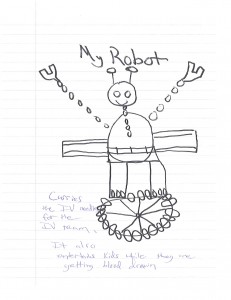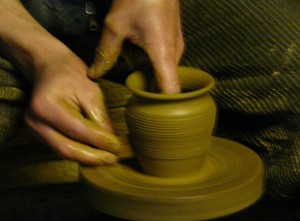Brian Rosman, the Robotic Surgery Research Fellow in the Department of Urology at Children’s Hospital Boston, contributed to this post.

Children and parents connect with home robots that "embody" their health care provider. (Image submitted by a patient at Children's Hospital Boston)
Robotic technology can take many forms. In the Department of Urology at Children’s Hospital Boston, we are evaluating a remotely controlled, videoconferencing robot on wheels to help transition our patients’ care to the home after surgery. This transition is a time of significant anxiety for all. In the hospital, children have around-the-clock care and monitoring; after discharge, families tend to lose contact with their physicians and nurses unless there is a problem or complication.
The robot we’re testing, the VGo, allows us to make virtual house calls. As children recover in familiar and comfortable surroundings, with their families around them, we can talk to them, monitor them, view their home environment, help parents assess their child’s status and answer their questions and concerns. We can sometimes identify errors and avoid complications before they require emergent and costly medical attention.
We’re often asked why we use this mobile robotic system, a relatively new and costly technology, rather than established, less expensive alternatives such as cell phones or computer-based videoconferencing programs like Skype or Facetime. Full story »
This robot, proposed by a patient at Children's Hospital Boston, would check vitals and tell stories.
It can’t be ignored that dramatic transformation in our healthcare system is imminent. The economy, market forces and increasing political demands will soon force physicians and healthcare professionals to change how we take care of our patients. Just as the days of housecalls are gone, so is our current system of delivering care.
The rising cost of healthcare now has the government and insurance companies placing more emphasis on controlling costs, sometimes at the expense of quality. They demand that we become more efficient and manage an even greater number of patients. Advancements in medical technology are believed to be a principal cause of the rising cost of healthcare: While they have improved patient care, they often come with a high price tag.
Does that mean we should abandon them? My answer is to play with robots. Full story »
Hiep Nguyen (L) and two of his Kenyan colleagues during one of the 41 procedures they performed together in five days. (Photo: Kelly Kristof and Hiep Nguyen)
For over a decade, Hiep Nguyen, MD, FAAP has been traveling the world as part of a nonprofit surgical and education team, dedicated to improving pediatric urology in developing countries. Nguyen’s recent experiences leading a surgical team in Kenya highlighted the need for a better way to keep his international colleagues up to date on the rapidly evolving field of pediatric urologic surgery.
Once a year, I lead a group of dedicated volunteers from International Volunteers in Urology (or IVUmed) to a remote part of the world to help train local physicians to care for children with urological problems, in particular congenital anomalies of the genitourinary tract. Despite these conditions being common – they affect between two and 15 percent of all children – very few physicians are specifically trained to take care of children who have them. The ways in which we diagnose and care for congenital urological problems are evolving rapidly and, consequently, such care is increasingly delivered by full-time specialists – specialists who are often in limited supply, especially outside of the United States.
On a trip to Kenya last month, our IVUmed team, assisted by the local surgeons, operated on 41 patients in five days. In the process, the physicians there got their first exposure to many aspects of diagnosing and managing congenital genitourinary malformations. They soaked up the knowledge with enthusiasm and demanded more, but unfortunately, our time there was limited, and it will be another year before we return and resume their education.
Despite the success of these trips, I always sense that we could do a better job if we could work with our colleagues overseas more consistently and expose them more constantly to the urologic techniques and concepts we teach. But it is impossible to be there with them every day.
Or is it? Full story »
 Hiep Nguyen is a pediatric urologist and surgeon at Children’s Hospital Boston, where he directs the Robotic Surgery Research and Training Center and is chair of Innovative Urological Technology. Off-hours, Nguyen is a painter, potter and photographer.
Hiep Nguyen is a pediatric urologist and surgeon at Children’s Hospital Boston, where he directs the Robotic Surgery Research and Training Center and is chair of Innovative Urological Technology. Off-hours, Nguyen is a painter, potter and photographer.
An amorphous piece of clay spun on the pottery wheel. A gentle pair of hands made quick graceful movements, and within minutes a beautiful bowl emerged. I watched in amazement how simply my friend and pottery colleague brought a piece of art to life.
Any other day, she would have smiled and marveled at her creation, but not this day. This day she grimaced and gently wrapped her arms around her belly. Being a physician, I’d seen this face before — one of pain. In Holly’s case, it is one that I have seen too often during the last several months. Full story »

Daydreaming, Eugene de Blaas (1843-1931)
Things have a way of coming back full circle.
As in the first day of TEDMED, the message today was about imagination. Scott Parazynski, a physician and astronaut, reminded the audience about daring to imagine. As a child, he dreamed about flying in space and climbing to the peak of Mount Everest. As an adult, he made those dreams a reality, because he just dared to image. Nathaniel Pearson, a genomicist at Knome Inc., and Greg Lucier, the CEO of Life Technologies, both asked the audience to imagine a future in which patients come to their physician’s office to have their genome mapped and receive treatments tailor-made for them based upon their genetics. Full story »

In this aquarium in Japan, staff bow to the whale. (Image by gwaar, via Flickr)
What did my inner child learn today from 32 speakers? Just one special word: R-E-S-P-E-C-T.
Clifton Leaf, a journalist and author, demonstrated that while the reported age-adjusted rate of cancer appears to be decreasing, the gross cancer death rate actually is increased. The message was clear: we underestimated this disease. Anna Barker, former deputy director of the National Cancer Institute, echoed this message in recounting our war on cancer. Our lack of respect for the disease’s complexity misdirected our efforts and resources. Full story »
Image by aussiegall (Louise Docker) via Flickr
Eight hours of talks from 30 speakers, from various walks of life… Was it overwhelming, boring or excessive? Not in the least. Today’s TEDMED talks were thought provoking, leaving us much to contemplate about death and disease. Today’s theme was accepting our responsibility for many of the diseases we are facing today.
Peter Daszak, a disease ecologist, reminded us that many devastating human diseases came from animal reservoirs. Full story »
This is the coolest meeting I have ever been to. I’ve become used to medical meetings where there are endless talks that often leave the audience less than inspired. If last evening was any indication, this meeting is all about inspiration.
Charity Tilleman-Dick opened TEDMED with her own inspiring story. As a world-class soprano, she was used to belting out arias in front of a full house. Now, she sang for an audience full of techies, physicians, artists and industrial leaders. After delivering an amazing performance, she revealed that the lungs that just generated these amazing sounds were not her own. Full story »











